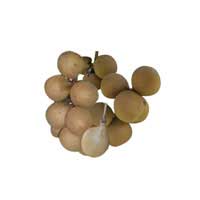 Full List of Fruits
Full List of Fruits  Kepel fruit
Kepel fruitKepel fruit
Scientific name - Stelechocarpus burahol
Known for producing edible fruits, Stelechocarpus burahol is recognized by several other common and local names such as the kepel, kepel fruit, keppel fruit, kepel apple, or burahol. They are from the humid evergreen forests of Southeast Asia and it is an annonaceous plant type. The fruit grown only in Java, it has been known in Java to have great value as an oral deodorant. When compared to the pulp and seed, the peel is believed to have the best adsorbent ability. Studies that were conducted during the year of 2012 states, that it reduces the odor of feces by activating the probiotic bacterium. They have also been used to treat gout traditionally.
With rigid and oval leaves that are lustrous, the fruit of this evergreen plant grows on the lower part of the trunk especially on the larger branches. Similar to that of a mango, they have a spicy flavor.
Kepel fruit, also known as the kepel apple, is a species of flowering plant in the family Anacardiaceae. It is native to Southeast Asia, where it is commonly found in Indonesia, Malaysia, Thailand, and Vietnam. The kepel fruit is a small, greenish-yellow, round to oval-shaped fruit with a thin, edible skin. The edible flesh is white and has a sweet, sour flavor.
![]() Health benefits of Kepel fruit
Health benefits of Kepel fruit
While the fruits are believed to have some functional properties that prevent kidney inflammation, the leaves are used to lower cholesterol levels. With diuretic properties present in the fruit, it is said that they are good for the kidneys helping averting stone formation and healthy functioning.
The kepel fruit is highly nutritious and is often eaten fresh or juiced. It is a good source of dietary fiber, vitamin C, and other minerals and vitamins. The kepel fruit is also rich in antioxidants, which can help protect the body from free radicals and other damaging substances.
The kepel fruit is often used in traditional medicine to treat ailments such as fever, diarrhea, and indigestion. In some countries, it is also used to treat skin conditions such as eczema and psoriasis.
The kepel fruit is also used to make jams, jellies, and relishes. It can also be dried and made into a powder for use as a flavoring agent. The fruit is also sometimes used to make a refreshing drink.
The kepel fruit has a long history of use in Southeast Asia and is still widely consumed today. It is an important part of many local diets and is considered a nutritious and tasty snack.
Propagated from seed easily, these fruits grow in a hot, humid climate and can be planted at sea level, up to 300 m. Though it can germinate quickly, it will take a period of 12 months or more to develop seedling shoots. In and around eight years, the tree will start to bear out fruits and produces year round. As aforesaid, they are propagated from seeds, but they are taken from mature fruits. With slow seed germination, the process of scarification is recommended by some. For the tree to come into bearing it will take a period of 6-9 years and the seedlings are planted apart 8-10m.
Kepel fruits, also known as ambarella, are native to Southeast Asia and are related to the lychee, rambutan, and longan fruits. Kepel fruits have a unique flavor, as they possess a combination of tartness, sweetness, and sourness, and are commonly used as a flavoring agent in many dishes.
Kepel fruits are a great source of vitamins and minerals. They are a rich source of vitamin C, and they provide a significant amount of dietary fiber, which helps to keep the digestive system healthy. Kepel fruits also contain high levels of potassium, magnesium, and phosphorus, which are important for maintaining healthy bones and teeth.
Kepel fruits can be eaten fresh or used in recipes to add flavor and nutrition. Fresh kepel fruits can be served as a snack or can be cut into thin slices and added to salads or other dishes. The flesh of the fruit can be used to make jams, jellies, and sauces, or can be blended and used as a marinade for meats. Kepel fruits can also be blended with other fruits to make delicious smoothies or juices.
The juice of kepel fruits can be used as an ingredient in cocktails and other beverages. The juice can also be used to make ice cream, sorbet, and other desserts. Kepel fruits can also be dried and ground into a powder, which can be used to flavor dishes such as curries, stews, and soups. The powder can also be used as a topping on desserts or as a flavoring agent in baked items.
Kepel fruits are often used in traditional medicine to treat a variety of ailments, including fever, colds, and digestive disorders. The fruit is also said to possess anti-inflammatory properties, which can help reduce inflammation in the body. The leaves of the kepel tree are also used to make a herbal tea that is believed to be beneficial for the respiratory system.
Kepel fruits are an excellent source of dietary fiber, which helps promote a healthy digestive system. The dietary fiber found in kepel fruits can help reduce cholesterol levels and promote weight loss. They are also a good source of potassium, which is important for maintaining healthy bones and teeth.
Kepel fruits have a unique flavor profile and can be used in a variety of recipes. They can be eaten fresh, used in jams and jellies, or blended into smoothies and juices. Kepel fruits are also used in traditional medicine and are said to possess anti-inflammatory and digestive-aiding properties. Kepel fruits are an excellent source of dietary fiber and help promote a healthy digestive system. They are also a good source of potassium, which is important for maintaining healthy bones and teeth.


















